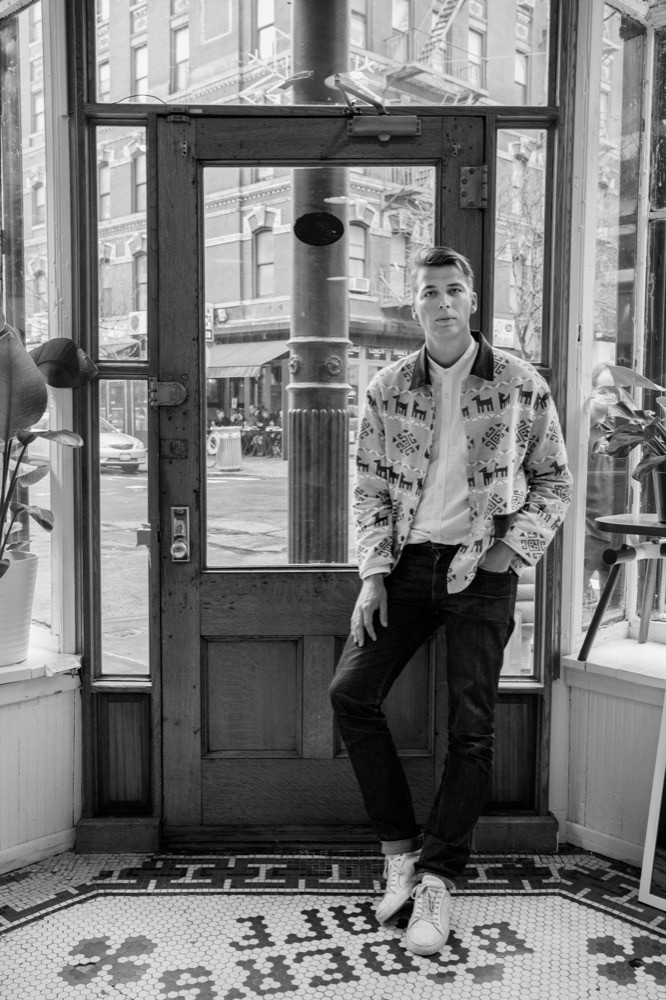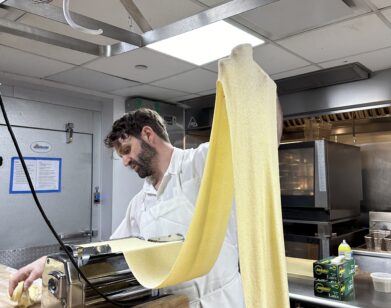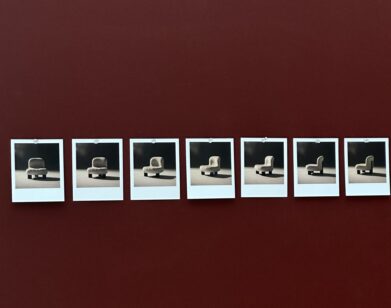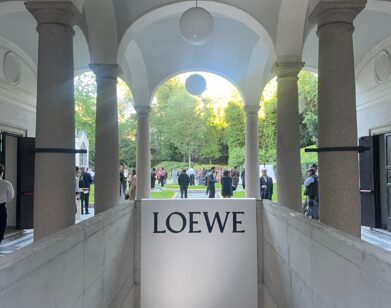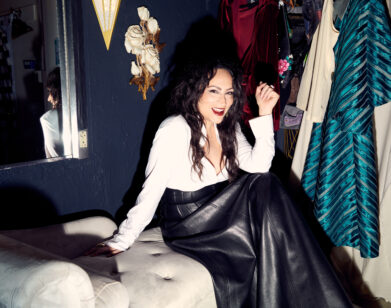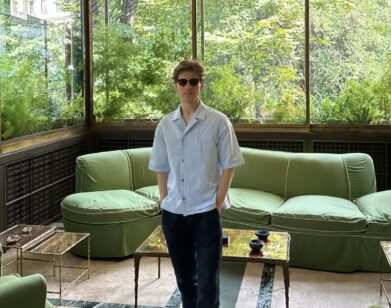Tictail Takes New York
PHOTOS: MARK DAVIS.
Over 100,000 brands around the world use Swedish startup Tictail to power their online stores. There’s the Whitechapel Bell Foundry, a church bell manufacturer in East London established in 1570; by Mutti, a crockery and textile company that sells classic blue and white ceramics with unusual designs (a skull and cross bones, for example); and Beard Baubles, a seasonal company that makes Christmas lights for hipster beards and one of CEO Carl Waldekranz’s personal favorites. Then there are thousands of independent fashion designers like DDUGOFF, Alex Crane, Wray Collection, and Mes Dames. The rules are pretty simple: as long as they aren’t doing anything illegal or horrendously offensive, any business can have a Tictail digital storefront.
Co-founded in May 2012 by Stockholm native Waldekranz, his childhood friend Kaj Drobin, and developers Siavash Ghorbani and Birk Nilsson, Tictail hopes to democratize e-commerce by creating the “most used, but more importantly most loved, e-commerce platform.” There is also a sense of a group of insatiable entrepreneurs. For Drobin and Waldekranz, who have started businesses together before, including a consulting agency they eventually sold to Sweden’s biggest “brand development” company Identity Works, Tictail offers endless opportunities to foster and grow new companies.
This year marks a new phase in the platform’s trajectory. After experimenting with pop-up shops in Stockholm, Paris, and New York, today Tictail opens its first-ever permanent store. It is in the same location as the most recent pop-up: Orchard Street in Manhattan’s Lower East Side. Since the pop-up closed at the end of last month, however, Tictail has doubled the amount of brands on offer. They also plan to invite a different artist to takeover the store’s mural each month, beginning with Mike Perry.
“The purpose of the selection is to really celebrate the global community that is Tictail—to show that if you’re looking for local brands from Paris, London, Barcelona, Stockholm, you can find them wherever you are in the world,” explains Waldekranz. “We want the store to be a very living destination,” he continues. “I want to think of it more like a gallery than a store—something that can change every week, every month. Where we can turn the store into a restaurant for a week or, during New York fashion week, a platform for all of our independent designers to showcase their newest collections to journalists.”
Currently, Tictail has offices in New York and Stockholm. When asked about competitors, Waldekranz skips over other platforms that offer similar services such as Etsy, focusing instead on the companies his users are up against. “For us to become successful, our stores need to become successful,” he says. “When we’re trying to make an independent fashion designer find customers, we have to help that designer get customers from the global, faceless e-commerce brands like ASOS, Net-a-Porter, Amazon.”
EMMA BROWN: Your mother designs by Mutti?
CARL WALDEKRANZ: Yes. It’s always a shameless family plug whenever I interview. My mum is by Mutti, and by Mutti also means “by Mother.” She’s been an artist my entire life. She used to do these huge paintings and sculptures, but then four years ago now, she took this really cool, brave leap in her career. She left handmade production behind and she found this factory in China and a warehouse in Stockholm. She had this idea of mixing something traditional with something more modern, and out of that came by Mutti. I think a lot of the discussions I had with her back then is what eventually formed Tictail. She represented, to me, this new generation of entrepreneurs, people who would have never started their own business 20 years ago or so, but it’s become easier and less expensive than ever before. They’re quitting their day jobs; they’re working weekends to make ends meet. They’re doing design, marketing, finance—everything that’s a business, one person does today.
BROWN: Were you already thinking of doing something like Tictail, or was it really all through talking to your mother?
WALDEKRANZ: Tictail is actually my third company. So I always had that entrepreneurial vein going. I think I knew that I would probably build businesses my entire life in some shape or form. When we were working at the advertising agency [Identity Works] before going into Tictail, we were working with so many really fantastic clients—great people, really cool challenges—but it became so frustrating that every time you only had three or four months to make your mark, and then you had to repeat and go to the next client and start over. You could never follow the work you did as it went into the hands of consumers and users. Before we knew what Tictail was and before we’d decided that we would start an e-commerce platform, we decided the next company we started —me and Kaj, who I started all of my companies with—should be something that’s long term. It should be a product, something that we can control the destiny of, and it should be something that has an impact on the world around us. That was the framework. Within that framework, we explored a bunch of different opportunities, but it was my mother who pointed us in the right direction.
BROWN: Was the first company you started the nightclub program?
WALDEKRANZ: My first, first company was an agency called Super Strikers. I wouldn’t call it a company. If it was anything, back then it was an experiment. We had just come out of high school. All of our friends went on this gap year to Asia to travel and find their spiritual self, or just get pissed on the beach. But Kaj and I had been toying around with design a bunch after school so we just decided, “Let’s just take this year between high school and university to build an agency and see where it goes.” We created Super Strikers, which was kind of like, “We’re an agency that does whatever you’ll pay us to do. If anyone wants to work with us, just define what work is and we’ll try to learn it and we’ll do it.” Initially with Super Strikers, we had zero customers. When you run an agency and you don’t have any customers, what you find yourself having is a lot of time. You’re just showing up at an office day after day and no idea what to do.
BROWN: But you had an office?
WALDEKRANZ: Yeah. I had an office before I had an apartment. I had business cards, an office, and cool, expensive magazines on a table when you came in, but no one ever came in. That’s when we started building this guest list platform called “Keyflow.” It was more of a hack or an idea than a strategic move. We were 18 years old and liked nightclubs, and we realized that it was really inefficient the way nightclubs work—you have these long guest lists and no one can ever find anyone. We decided we would build a smarter platform to handle guest lists where the guards would have a small handheld device—this was before the iPhone, the first consumer touch screen phone called the Nokia 7710—that would just connect to the internet and would keep all the guest lists in sync. The killer feature was that nightclub managers or DJs could add names to the guest list via text message. This was genius. Everybody loved this. We built this over a few weeks, gave it to one nightclub for free just to try it out, and then a week after every nightclub in Stockholm called us.
It was Keyflow that actually made our agency a success. This was 2006, 2007, and there was a tiny startup in Sweden called Spotify. They had this idea that they wanted to change music. One of my friends had received an invitation to use Spotify, and I saw this program that was too good to be true. I was like, “I have to get my hands on this program.” So I emailed the marketing director and said, “Can I please get an invitation to try out your software? It looks so cool.” And she responded to me saying, “That’s nice, but no. Because of legal limitations we can’t give out more invites right now.” And I was like, “Okay, I understand that. But this has become something of an addiction, please keep me in mind, and while you do, I’ve added you plus five to the guest list of one of these really cool nightclubs in Stockholm. You can go there whenever you want and see what we’re working on.” That earned me a meeting with her, and in that meeting, I was able to pitch our agency. They were about to launch and they needed a small company to help build their website and help do their launch campaign, so we were able to win that contract. Spotify became our first customer in the agency, and later, of course, became a huge, huge success, and put us on a really successful trajectory as a company. As our agency grew, we started working with a bunch of different clients. Nokia was one of them. Rosetta Stone here in the U.S. We ran the agency and the guest list business in parallel, but separate.
BROWN: When did you meet the two other founders of Tictail?
WALDEKRANZ: The first guy, Birk, we actually found him through an interview. We tried to recruit him. We were trying to recruit developers, engineers, for Super Strikers and we heard about this young guy who was this fantastic developer—a complete prodigy—called Birk. I was like, “That’s a weird name.” That was probably my first reaction. Then my second reaction was, “I would love to meet him.” So we met up and we had a beer and I told him about our agency. He was working at a big newspaper in Sweden, and he quickly realized he didn’t want to go into the agency world. He wanted to tackle bigger technical challenges as opposed to building campaigns. I really liked him, and we left that conversation saying, “Okay, we’re not going to be able to work together, but let’s stay in touch.” Over the next few years, I would once a month try and recruit Birk and he would always say no. Then when me and Kaj started talking about building a product instead, the first person that came to mind was of course Birk. Birk had spent a bunch of time working in e-commerce and helping out friends and family in building their sites, and he really had a genuine interest, so he came on board immediately.
Then the three of us started working over the weekends. We would meet every Friday in my kitchen and work Friday through Sunday just prototyping. We did that for six months. Every month, the three of us took half of our salary and put it in a joint savings account. That became the starting capital of Tictail. We put up one of these landing pages, the ones that all startups have, “We’re working on this great thing that’s going to revolutionize e-commerce, sign up here to get early access.” We didn’t think much of it. One night, I’m on my way home, and Birk calls me on the phone: “Carl, you cannot believe what just happened. We just received an email.” In the source code of our landing page, in the very bottom where you include the javascript, we had hidden this small message, “If you find this message, you’re probably as eager a developer as we are, and you should get in touch. We’re looking to expand the team.” Some guy had gone into our webpage and found that small message into space. We were just so shocked that anyone had found us. We were like, “Call him!” Birk calls him up and they’re on the phone for an hour and a half. We learn that this guy is called Siavash, he’s a fantastic engineer, he’s tech lead for Blocket, which is like Craigslist in Sweden—Sweden’s biggest site. We decided we were going to meet him for coffee the day after. It’s supposed to be half an hour, and we end up speaking for six or seven hours. Then he just starts stopping by our office every day on his way home from work. He starts contributing code and ideas. Three or four months later, we realize we are completely dependent on this guy. So we were like, “Want to quit your job and start this company with us?” That’s probably the best decision I’ve made in my entire life.
BROWN: I know your mother’s shop was the first Tictail store, but do you remember the first shop opened by someone you didn’t know beforehand?
WALDEKRANZ: I can’t say I do. I should know. It’s funny how things happen. When we were building Tictail, the one moment we always celebrated internally before we launched was, “Can you imagine when we have the first customer who we don’t know to any store.” But we launched Tictail at a huge conference in front of 5,000 people. You always imagine it’s going to be one customer, and then the second customer, and then the third customer. For us, it was a year of really, really hard work without seeing any signs of success, and then overnight a lot of activity.
BROWN: When did you decide that you wanted to open a physical Tictail shop?
WALDEKRANZ: When we started the company, we always said that we are not an e-commerce company. Our mission is to empower independent brands and make them successful. This is our reason for being. Then we kind of thought to ourselves, if that’s our reason for being, what’s the best and fastest way for us to accomplish this, and e-commerce was the obvious answer. It’s a highly scalable, fast-growing category. Now, when we think about the future, e-commerce was the first step to accomplish this mission, but we’re excited about all kinds of different channels. I want to be the home and center to any different brand, and I want to be able to fulfill all of their needs, be it advertising, shipping, their online store, order management, or their first retail experience. Our first retail experiment happened last year, when we did the first pop-up store. I like to think of it as an experiment—if we were to have a retail presence, what would that look like. It was a huge success. We learnt that there’s a huge interest from today’s shoppers in the type of brands that we support. We started developing that idea further—maybe the next step of Tictail is to blur the line between physical and digital. The concept of going into permanent retail started to emerge. We didn’t think it would happen this soon, but the space that we found here in New York is the perfect space. That neighborhood, the Lower East Side, feels very much like the neighborhood that Tictail would be if we were a location somewhere in a city.
TICTAIL’S FIRST PERMANENT STORE OPENS TODAY, JANUARY 11, AT 90 ORCHARD STREET IN NEW YORK CITY. FOR MORE INFORMATION, VISIT THE TICTAIL WEBSITE.

